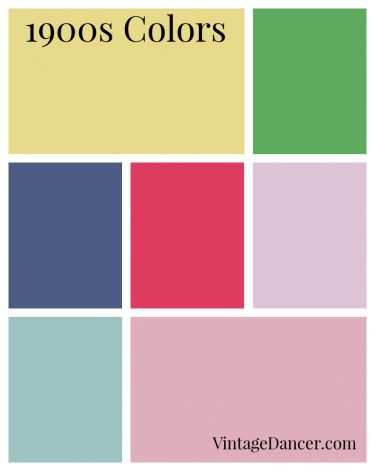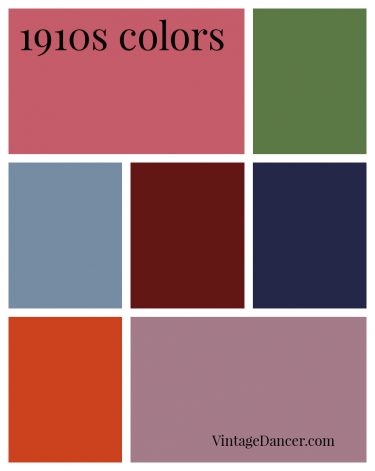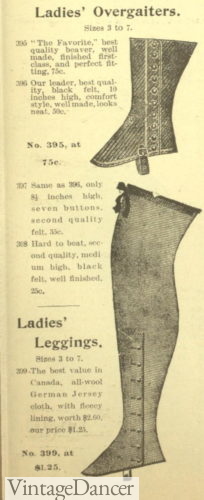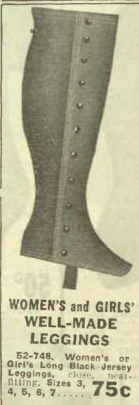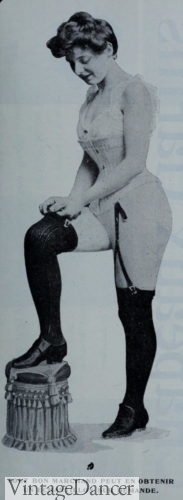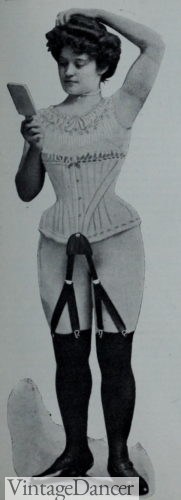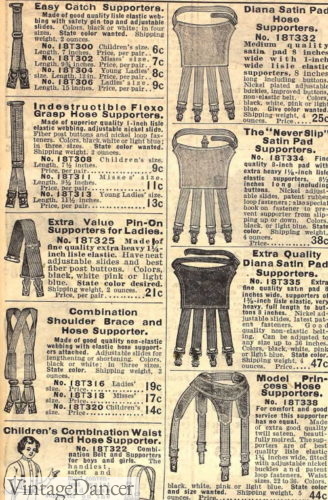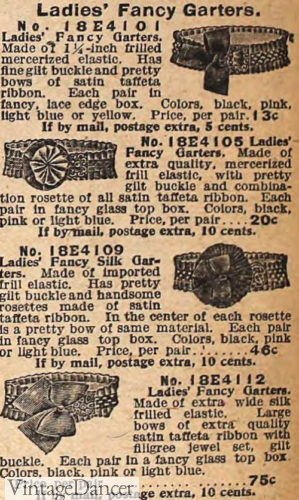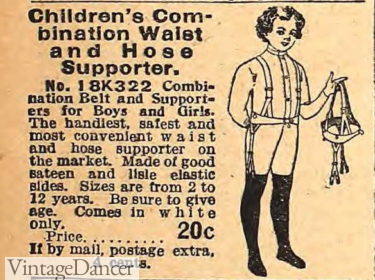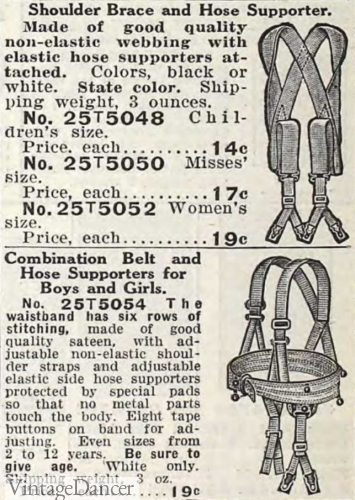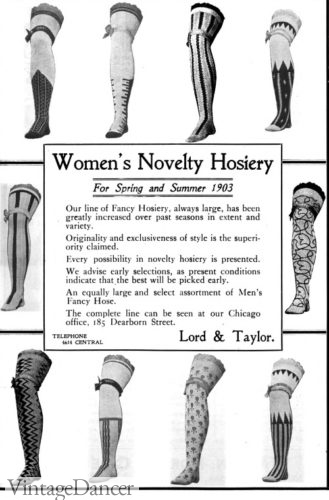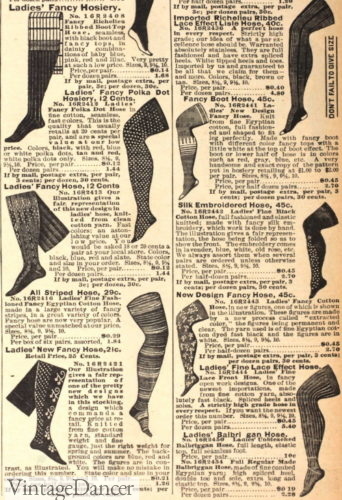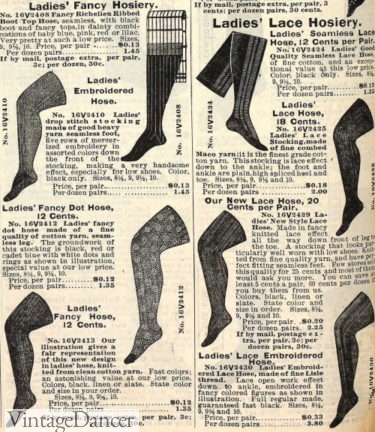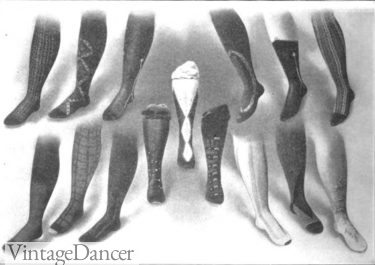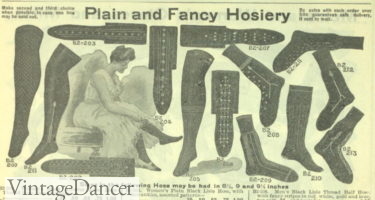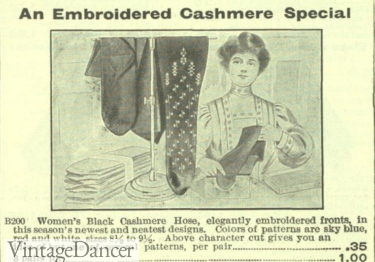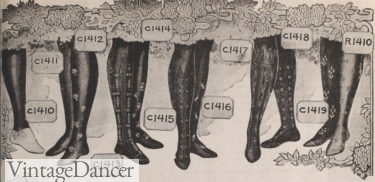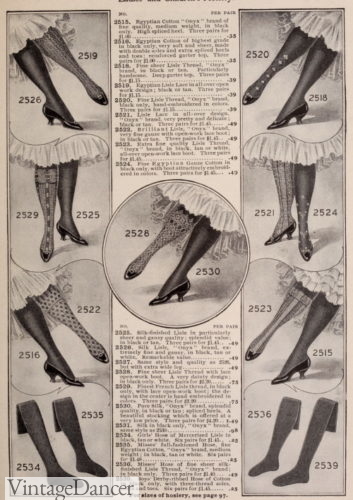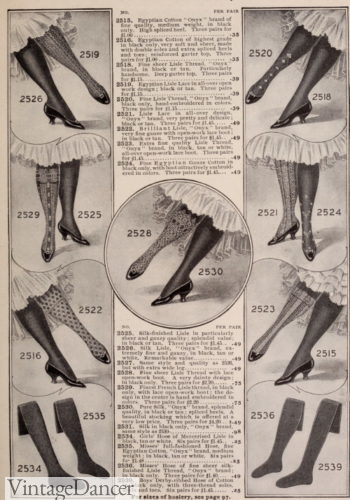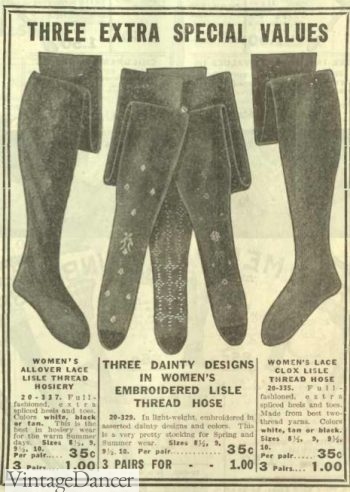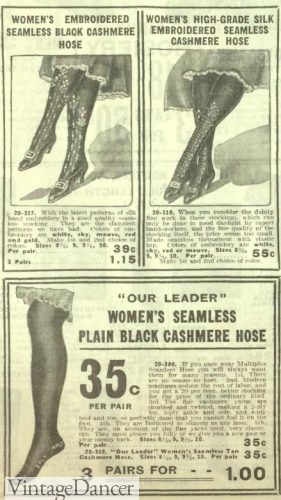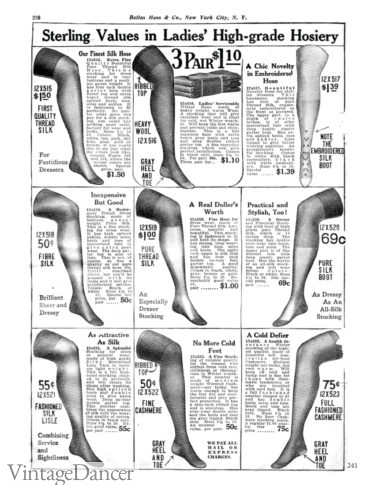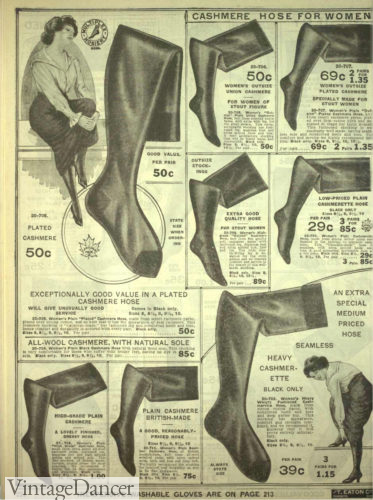During the Edwardian period, women’s hosiery or stockings, expanded in color and texture. This varied by country to some degree. English women preferred to match stockings to the hat, veil or belt. The French woman matched her stockings to her dress or shoes. American women were the least exciting, preferred to embrace practical brown or black stockings with colored embroidery.
Jump to the end to see where to buy Edwardian style stockings.
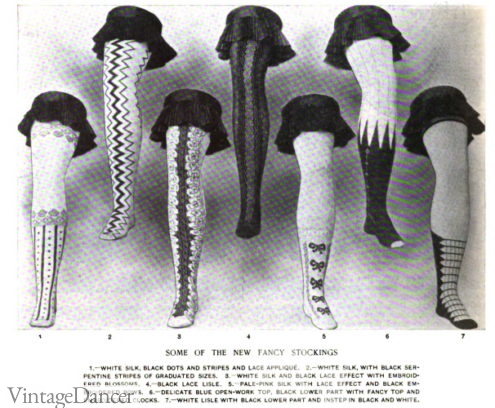
1903 fancy pattern stockings
The focus on women’s stockings in the Victorian era was to wear practical hosiery or if she were interesting, a fancy pair that was only know to her and her maid. As hemlines grew shorter in the Edwardian era, the visibility of stockings because something to notice, talk about, and judge.
“The great vogue of short-skirted frocks among smartly gowned women necessitates that much more attention shall be paid to their hosiery than has been given under different fashions and in consequence there is a great demand for stockings that shall harmonize with every detail of the dress, and this means many pairs different in color and ornamentation” says Vogue, 1907.
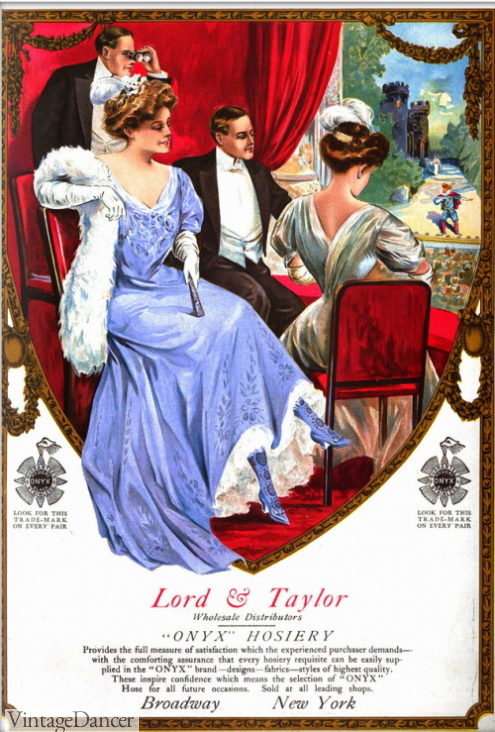
1907, a ladies stockings were visible under shorter hemlines. Matching stockings to dress was common practice.
Silk sheer stockings inset with lace, hand-embordered with small flowers, leaves or repeating patterns, or hand painted lace effects were the best of the best. Most decoration centered on the front of the hose up to the knee or along the side in clocked patterns.
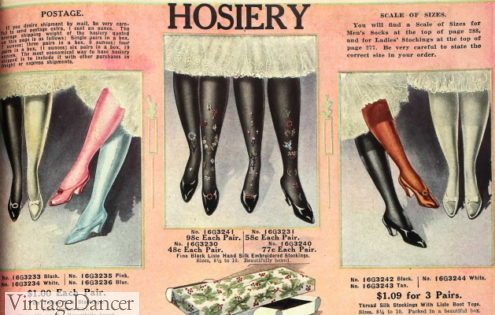
1911 fancy stockings

1911 fancy silk stockings
Small pin dots, hairlines of contrasting color, tiny checks, wide stripes, and chevron were more of the very plentiful patterns. Plaid and big stripes were for traveling or sport players.
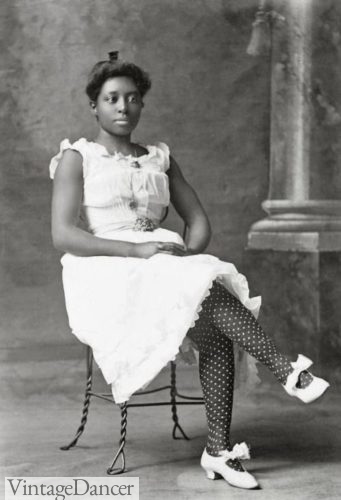
1899- Fabulous embroidered pin dot stockings!
Color choices were as varied as any dress fabric. Violet, pink, light blue, navy blue, yellow, green, teal, red, copper as well as white, black, brown and grey.
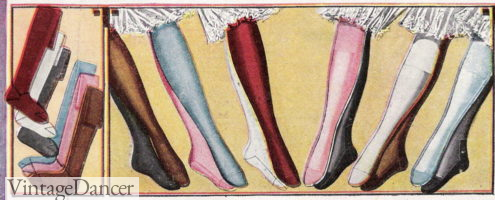
1914 knit and silk stockings
- 1900s colors for women
- 1910s colors for women
Poor women or for day to day uses by all classes, had shoppers picking up cotton, lisle or cheap wool black stockings in smooth or rib knits. These could have machine-made lace or embroidery inserted onto the hose. Knitting stockings at home was more economical and better fitting.
Most hose were cut in the Fully Fashioned style, meaning it was cut and sew into the shape of a leg, this made them ill-fitting if a leg shape was anything but standard. “Out size” stockings were available for plus size legged women.
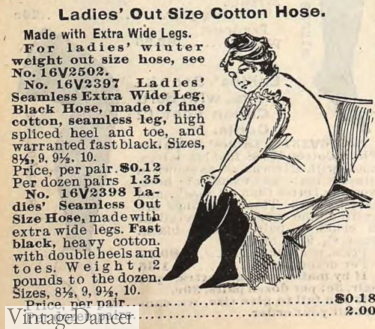
1903 plus size seamless cotton stockings (out size)
Seamless stockings were knit into a tubular shape. To make them stronger heels and toes were double knit layers. The heel could extended up to mid calf when worn with taller boots.
Winter Stockings
Cashmere was the more luxurious wool stocking choice that came is weights for summer and winter. Other winter stockings were fleece lined cotton, merino wool, and heavy wool. Most were a ribbed knit in black or dark grey. Some had an elastic band at the top to help hold them up comfortably.
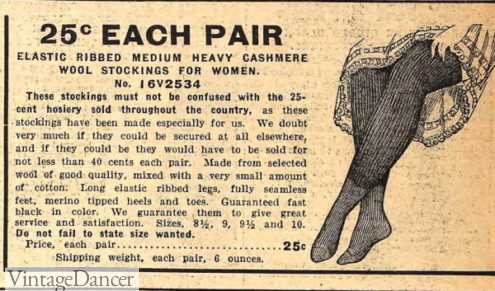
1910 cashmere ribbed black winter stockings
When a single pair of stockings was not warm enough women began to layer. Long underwear made of two pieces, a vest top and leggings bottoms, were put on first. Then came an optional pair of tights.
The difference between underwear bottoms and tights were the open back for toileting needs found on underwear. Tights, like leggings, pulled on over the underwear and could also be topped with stockings (3 layers!)
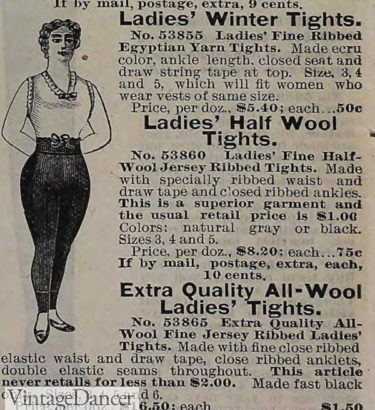
1900 women’s knit tights
Yes another optional layer were gaiters or leggings. These were button up spats that fit over boots and shoes and could extend up and over the calf or knee. They were made of fleece lined soft jersey.
- 1900 gaiter and over the knee leggings
- 1913 leggings
With all of these stockings, tights, and leggings options plus several layers of petticoats women and girls were quite warm in winter.
Hose Supporters
How did Edwardian women hold up stockings?
Wearing stockings was not an easy business. Today we have tights with elastic that work much better but in the Edwardian era there was no such thing. Stockings were held up with garter straps called hose supporters that attached to the corset or to a separate supporter pad (essentially a garter belt) worn over the corset. As seen below elastic straps attached to the front of the corset whereas later vintage garters attached front and back.
- 1901 garter clips
- 1902 corset garter clip
Hose supporters were also sold attached to corsets, up to 6 straps front and sides. These did the best job at keeping hose from falling down.
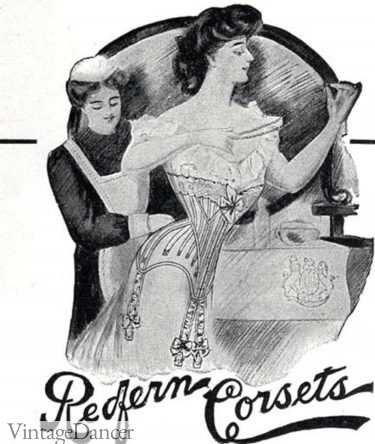
1906 corset with ruffled garter straps
The worst but prettiest holders were elastic leg garters. They circled the thigh. Too tight and they cut off circulations. Too loose and the hose would quickly be at the knees. The disappeared around 1910 but came back in the 1920s when flappers rolled their stockings with them.
- 1910 hose supporter belts and elastic straps
- 1905 pretty hose garters
The Pantella stocking was designed to fit over the entire leg and button onto the corset. Notice how they were worn over long underwear. These not only provided two layers of warmth but a smoother line under narrow fitting skirts.
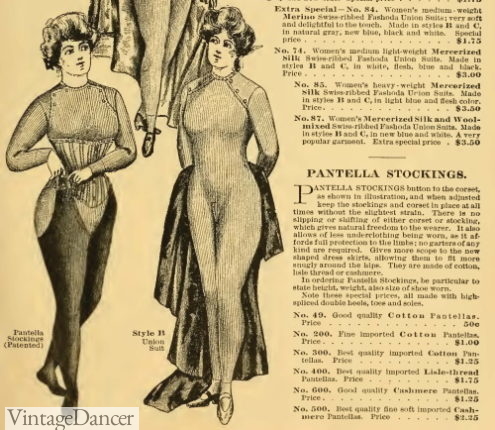
1902 Pantella stockings
Stocking Holders for Girls
The full leg stocking idea was borrowed from girls clothing. Babies and young girls before wearing corsets with garter clips would attach stockings to the inside of slips (chemise) or petticoats. They could be attached with cheap buttons, safety pins, ribbon ties or pin on garter straps.
The same pin-on garter clips sold to women were made in children’s sizes. These were probably the most commonly used form of stocking holder for children and teens:
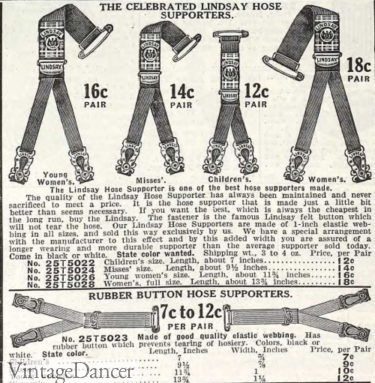
1914 safety pin on garter straps
Fore active children (boys and girls) there were hose supports that looked like suspenders with/without belts such as these:
- 1908 wearing a hose supporter for children
- 1914 hose supporters for children – suspender and belt styles
Where to buy Edwardian Stockings
Pretty embroidered silk stockings will be nearly impossible to find. Most ladies will choose basic black, white or brown tall socks or full tights to wear under Edwardian dresses and skirts. Wool or pure cotton knee high socks will be the most authentic and warmest. Pretty lace, polka dot, plaid or striped semi-sheer stockings will give the closest look to Edwardian embroidered hose.
Falke – Has over the knee socks in black wool
Wolford – Also makes wool socks and stockings
Sock Dreams– A good assortment of thigh high and over the knee knit socks and stockings. Plus sizes too.
Snag Tights – Basic wool, sheer or pattern full tights for plus sizes. Women rave about these!
American Duchess– Silk thigh high stockings. Clocked stockings. Early design that carry into the Edwardian era.
Amazon – Over the knee lace knit socks and pattern tights.
Here are some additional stocking examples from ladies clothing catalogs. You will have to imagine all the beautiful colors!
- 1903 novelty hose
- 1902 fancy stockings
- 1903 hosiery
- 1905 stockings
- 1904 fancy hosiery
- 1906 pattern stockings
- 1907 embroidered cashmere
- 1908
- 1908
- 1908
- 1913 Cotton Clox Tights
- 1913 cashmere stockings
- 1917 stockings – silk, lisle, cashmere
- 1918 stockings
Debbie Sessions has been teaching fashion history and helping people dress for vintage themed events since 2009. She has turned a hobby into VintageDancer.com with hundreds of well researched articles and hand picked links to vintage inspired clothing online. She aims to make dressing accurately (or not) an affordable option for all. Oh, and she dances too.
